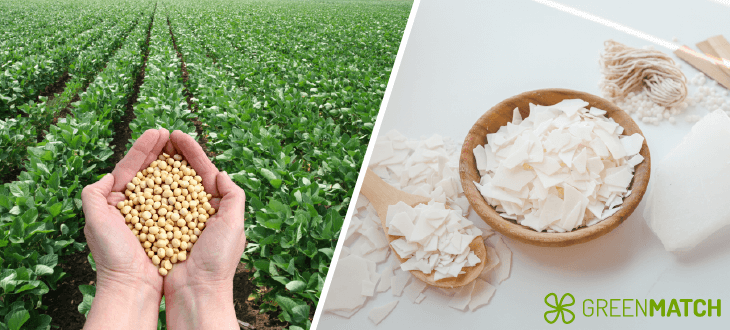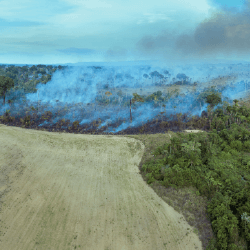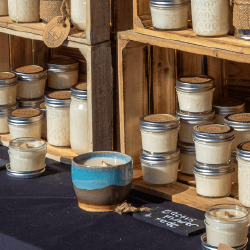- GreenMatch
- Blog
- Is Soy Wax Bad For The Environment? Statistics And Facts
Is Soy Wax Bad For The Environment?

Are soy wax candles lighting up environmental concerns?
Soy wax candles have become a popular alternative to traditional paraffin wax candles, often marketed as a more eco-friendly option. But is soy wax truly better for the environment?

The term "natural" is often used to market soy wax candles, but this can be misleading. While soybeans are natural, turning them into wax is not. "100% soy wax" can also be deceptive, as most candles contain additives to improve burn quality.
Although it is considered a carbon-neutral product, the CO2 released during burning is offset by the CO2 absorbed by soy plants during their growth. However, this does not account for the carbon emissions associated with the farming, processing, and transportation of soybeans.
Let’s delve into the environmental impact of soy wax, comparing it to traditional paraffin wax and exploring its benefits and potential drawbacks. From its production process to its biodegradability and the role of GMOs, we'll uncover whether it truly lives up to its eco-friendly reputation.
What do we mean by soy wax exactly?
Soy wax is a vegetable wax derived from soybean oil, making it a renewable and biodegradable alternative to traditional paraffin wax.
The oil is then extracted and hydrogenated to create a solid form suitable for candle-making. This process significantly alters the oil's melting point, solidifying it at room temperature and transforming it into soy wax.
Many soybeans used for wax production are genetically modified and grown using pesticides and herbicides. These practices lead to environmental pollution and leave residues in the final product.
Environmental impact of soy wax
Soy wax is often touted as eco-friendly due to its biodegradability and renewable nature. However, the environmental impact of soy wax is nuanced, involving aspects of production, usage, and disposal.
The expansion of soy cultivation in Brazil alone is linked to 500 sq km of deforestation yearly, with the carbon released in the process amounting to 1.5 billion tons annually.

Moreover, the use of pesticides and herbicides in soybean farming is a major environmental concern. These chemicals contaminate water supplies and harm non-target species, contributing to ecosystem imbalance. Over 80% of soybeans grown in the U.S. are genetically modified to withstand glyphosate, a herbicide known for its environmental and health risks. This widespread use of glyphosate has led to its detection in water supplies and human bloodstreams.
What is so bad about soy wax for the environment?
Despite its eco-friendly reputation, soy wax has its drawbacks. Concerns include:
- Deforestation: The expansion of soybean farming has contributed to deforestation, particularly in sensitive ecosystems like the Amazon Rainforest. This contributes to biodiversity loss and exacerbates climate change by releasing stored carbon dioxide when forests are cleared.
- GMOs and Pesticides: A significant portion of soybeans grown globally are genetically modified and may involve the use of pesticides, raising concerns about environmental and health impacts.
- Monoculture Farming: Large-scale soybean cultivation often involves monoculture practices, which can deplete soil nutrients and reduce biodiversity.
- Soil Degradation: Continuous soy cultivation in the same areas leads to soil erosion, reducing soil fertility and increasing the risk of flooding and pollution. This degradation impacts the land's agricultural value and the surrounding natural ecosystems.
- Greenhouse Gas Emissions: The equipment used in land clearing for soybean cultivation and processing soybeans into wax emits millions of tons of greenhouse gases, contributing to climate change.
- Water Pollution: The extensive use of pesticides and fertilisers in soy farming contaminates water sources, affecting aquatic ecosystems and human health.
- Socioeconomic Impacts: The expansion of soy cultivation areas can displace local communities and small-scale farmers, leading to social unrest and the unethical treatment of workers
What is the impact?
Total impact per year
According to the World Wildlife Fund, soy production is responsible for significant global deforestation. An estimated 4.2 million hectares of forest are lost annually due to soybean cultivation. This has far-reaching implications for biodiversity and carbon sequestration.
Impact per day
Daily, the environmental impact of soy wax can be observed in the form of habitat loss for countless species. Moreover, it contributes to indoor air pollution, though to a lesser extent than paraffin candles. The cumulative effect of daily soy wax usage can add to the overall demand for soy products, perpetuating the cycle of environmental degradation.
Impact per usage
Each time a soy wax candle is used, it contributes to the household's carbon footprint. While the impact per usage may seem minimal, the aggregate demand for soy products drives the environmental toll. Choosing soy wax candles with certifications like the Rainforest Alliance can help mitigate this impact.
Despite these challenges, paraffin wax offers several environmental benefits compared to paraffin wax derived from petroleum.
Here are key points highlighting its eco-friendliness:
- Renewable resource: Soy wax comes from soybeans, a renewable agricultural product.
- Biodegradable: Unlike paraffin wax, soy wax reduces landfill waste.
- Lower carbon footprint: Soy wax production has a lower carbon footprint than paraffin wax, contributing less to climate change.
- Supports local agriculture: The demand for soybeans for wax production can bolster local agriculture and economies.
- Cleaner burning: Soy wax candles burn cleaner, producing less soot and indoor air pollution.
Soy wax top production countries
According to the Food and Agriculture Organization Corporate Statistical Database, the global landscape of soybean production is dominated by a few key players.
Countries like Brazil, Argentina, Bolivia, and Paraguay have contributed to significant rainforest deforestation due to soy farming. It has been reported that Over the past two decades, 300 million hectares of tropical forests have been cleared, linked to annual deforestation.
Conversely, China is known for producing and consuming soy wax, which is driven by its large manufacturing sector. The EU import regulations and sustainability standards influence the global market dynamics.
Here is the list of top countries and their metric production:

Is soy wax toxic?
Soy wax is generally considered non-toxic. It doesn't release harmful substances when burned, making it a safer indoor air quality option than paraffin wax candles, which can emit carcinogens like benzene and toluene.
However, concerns have been raised about the potential for soy candles to produce small amounts of harmful substances. If not adequately manufactured or if they contain certain additives, volatile organic compounds (VOCs) have been linked to health issues such as headaches, respiratory problems, and even cancer.
Is soy wax biodegradable?
Yes, soy wax is biodegradable. This characteristic makes it an environmentally friendly choice for candle making and other applications. It is made from a natural and renewable resource that can break down easily compared to non-renewable petroleum-based waxes.
However, it's important to check for 100% natural soy wax candles, as some may include additives or blended waxes that could affect their biodegradability.
Soy wax vs Paraffin wax
| Attribute | Soy wax | Paraffin wax |
| Source | Renewable (soybeans oil) | Non-renewable (petroleum) |
| Biodegradability | Yes | No |
| Compostability | Yes (if pure) | No |
| Indoor Air Pollution | Less | More |
| Environmental Impact | Lower (Deforestation, GMO) | Higher (CO2 emissions, Toxins) |
| Carbon Emissions | Reduced | Higher |
Can soy wax be recycled?
Technically, soy wax can be recycled or reused in various ways. The leftover candles can be collected and melted to create new candles, melts, or even used for crafting.

This process not only extends the life of the wax but also reduces waste, aligning with eco-friendly practices.
To recycle soy wax, one typically needs to:
- Collect leftover wax from candles that are too low to burn or from scraps during candle making.
- Melt the collected wax gently to ensure it turns liquid without overheating.
- Filter out any impurities or debris, such as old wicks or burnt matches, to ensure the recycled wax is clean.
- Pour the melted, filtered wax into new moulds or containers with new wicks to create a new candle.
However, one of the main challenges in recycling soy wax is separating it from contaminants, such as wicks and fragrance oils. Cleaning and purifying the wax for reuse can be labour-intensive and sometimes cost-effective. Also, it's important to note whether the original soy wax contained fragrances or dyes. The recycled wax might inherit a mixture of these scents and colours, resulting in a unique but less predictable final product.
In addition, recycling on an industrial scale is not widely practised, primarily due to the need for established systems for wax recycling.
Are soy wax candles eco-friendly?
It is the most sustainable and eco-friendly option compared to paraffin wax candles. They are made from renewable resources and also support local agriculture. However, it's essential to be mindful of the sourcing and production practices to realise its eco-friendly potential fully.
The by-products of this process, such as soy solids, are often used as cattle feed, indicating resource efficiency in soy wax production. Approximately 60 kilograms of soybeans are needed to produce 10 kilograms of soybean oil, which is then processed into soy wax.
The process involves cleaning, cracking, de-hulling, and rolling soybeans into flakes. The oil is then extracted and hydrogenated to solidify it at room temperature. This makes soy wax a plant-based, biodegradable option compared to other wax.
Is soy wax sustainable?
The answer is not a simple yes or no. Though it presents a more sustainable alternative to paraffin wax, its environmental impact is considerable. The social impact also depends significantly on the farming and production practices employed.

They are often grown as a monoculture, leading to soil degradation and loss of biodiversity. Additionally, pesticides and fertilisers in soybean production can negatively impact local ecosystems and water quality.
However, it is a relatively low-impact crop, requiring minimal water compared to other crops.
Environmental impact compared to everyday things
The environmental footprint of products we use daily is a growing concern, with CO2 emissions being a primary indicator of sustainability.
A study has shown that burning palm stearin candles, a type of vegetable wax similar to soy wax produces a CO2 generation rate of 5.28 mg/s. This corresponds to 41.2 g of CO2 over a 130-minute experiment.
This is comparable to the CO2 produced by a resting human, about 80 to 100 watts of energy, consuming about the same amount of oxygen and producing the same amount of CO2.
| Everyday item | CO2 emissions | Notes |
| Soy Wax Candle | 41.2 g/130 min (5.28 mg/s) | Comparable to a resting human. |
| Paraffin Wax Candle | Higher than soy wax | Produces more soot and toxins. |
| Resting Human | 80-100 watts (similar to a candle) | Consumes oxygen and produces CO2 at a rate identical to candles |
| Vehicle (Average Car) | 2.31 kg CO2 per litre of gasoline burned | Based on a typical passenger vehicle. |
| Incandescent Light Bulb | 15 g CO2/hour | For a 60-watt bulb. |
| LED Light Bulb | 3 g CO2/hour | For a comparable 10-watt bulb. |
Surprisingly, commonplace items such as glass bottles, adhesive tape, and scented candles contribute to greenhouse gas emissions. Appliances like refrigerators and air conditioners contribute to CO2 emissions of 150-400 kg CO2 per year, depending on efficiency. This is through their energy use and the refrigerants they contain.
In addition, food production, particularly meat and dairy, has a substantial environmental footprint. According to recent data, beef tops the list with a staggering 99 kilograms of CO2e emitted per kilogram of the final meat product. Dark chocolate follows, with significant emissions attributed to land use changes, water consumption, and methane emissions.
Comparing the impact of soy wax to other everyday items highlights the importance of making informed choices across all aspects of our lives.
What are the alternatives?
Regarding candle making, soy wax has been popular due to its renewable nature and clean burn. However, there are several alternatives that not only match but can also surpass it in certain aspects.
Here's a concise overview of these alternatives:
- Beeswax: Produced by honeybees, beeswax candles burn brighter and longer without releasing toxic fumes, making them a natural and sustainable option. Beeswax tends to be more expensive than soy wax. It's also not vegan, which might concern some users.
- Coconut Wax: Derived from coconut oil, coconut wax is known for its clean burn and strong scent retention. It's a sustainable and biodegradable choice. Coconut wax also has a lower melting point, which can contribute to a longer burn time. It's praised for its environmental benefits and high-quality performance in candle-making
- Palm Wax: Made from hydrogenated palm oils, palm wax offers unique aesthetic qualities like a crystalline finish but raises concerns due to environmental impact.
- Rapeseed Wax: A vegan and eco-friendly option, rapeseed wax is known for its excellent fragrance retention and minimal carbon footprint, especially in Europe.
- Paraffin Wax: A byproduct of petroleum refining, paraffin wax is widely used due to its excellent scent throw and compatibility with dyes.
- Blend Waxes: this is a blend of natural waxes, such as soy and coconut or soy and beeswax, that offer a balance between sustainability, performance, and cost. These blends can optimise the benefits of each wax type, such as improved scent throw and burn time.
Each of these alternatives has unique properties, benefits, and considerations. The choice of wax will depend on individual preferences, values, and specific requirements for candle-making or other applications.
Is it better than its alternatives?
Whether soy wax is "better" than its alternatives depends on various factors, including environmental impact, health concerns, performance, and personal preferences. Let's compare soy wax to some of its main alternatives based on these aspects:
- Environmental impact: Concerns about deforestation and pesticide use in soy farming have been raised. Beeswax and coconut wax are excellent alternatives for those prioritising sustainability and minimal environmental impact.
- Burn quality and aesthetics: Beeswax and coconut wax candles offer longer burn times and a cleaner burn than soy wax. Palm and rapeseed waxes provide unique aesthetic qualities and are suitable for those looking for specific candle characteristics.
- Cost and accessibility: Soy wax is widely accessible and relatively affordable. Alternatives like coconut wax and beeswax are more expensive but offer distinct advantages such as superior scent throw and environmental benefits.
Statistics, facts and figures about soy wax
According to some studies, the U.S. market for soy wax is estimated at £1.2 billion, while China is forecast to grow at a CAGR of 17.9%.
The global soy wax market size was estimated at £4.5 billion in 2022 and is projected to reach £11.1 billion by 2030, growing at a CAGR of 11.7%.

The United States and Brazil are the world's top soy producers, contributing significantly to the global soy wax market.
Soy wax is primarily used in candle making but also finds applications in cosmetics and industrial products.
The top exporters of soy wax are China, Vietnam, and India.
Germany and the UK are notable markets in Europe, with an increasing demand for soy wax candles.
The key manufacturers in the global soy wax market include Golden Brands, CJ Robinson, Kerax, HCI, IGI Wax, BASF, SRS, EcoSoya, and NatureWax.
An estimated 60 million pounds of soybeans would be required for annual candle production by replacing paraffin wax with soy wax. This shift would economically benefit soybean farmers and promote a healthier environment.
China's soy wax market size was valued at £800 million in 2021 and is expected to grow steadily.
The European soy wax market is projected to reach £2 million by 2028, trailing a CAGR of 6.5% over the forecast period.
Pure soy wax accounted for 6% of the global soy wax market in 2021. It is projected to value £10.8 million by 2028, growing at a revised 7.2% CAGR post-COVID-19 period.
Frequently asked questions about soy wax
Soy wax is considered more environmentally friendly than traditional paraffin wax derived from petroleum. Soy wax is made from soybeans, a biodegradable renewable resource. Additionally, soy wax candles burn cleaner and produce less soot than paraffin candles, contributing less to indoor air pollution. However, it’s important to consider the entire lifecycle and production process of soy wax, including the use of pesticides in soybean farming and the potential for deforestation.
For optimal burning, trim the wick to 1/4″ before each lighting and allow the melt pool to reach the edges of the jar to prevent tunnelling. Recommended burn time is 3-4 hours.
Yes, soybeans can be grown sustainably using responsible farming practices. Look for soy wax labelled as “non-GMO” and “sustainably sourced” for the most eco-friendly option.
Yes, soy wax has a variety of applications beyond candle making. Due to its skin-safe properties, soy wax is often used in cosmetic products such as lip balms and lotions. It can also be used as a natural polish for wood and leather. The versatility and safety of soy wax make it a popular choice for a range of eco-friendly and personal care products.
Soy wax candles are non-toxic and do not release dangerous toxins into the air as they burn. Unlike paraffin candles, which can release carcinogens and other harmful chemicals, soy wax is a safer alternative for indoor air quality. Soy wax also produces significantly less soot than paraffin wax, reducing the risk of indoor air contamination.

Inemesit is a seasoned content writer with 9 years of experience in B2B and B2C. Her expertise in sustainability and green technologies guides readers towards eco-friendly choices, significantly contributing to the field of renewable energy and environmental sustainability.
We strive to connect our customers with the right product and supplier. Would you like to be part of GreenMatch?

